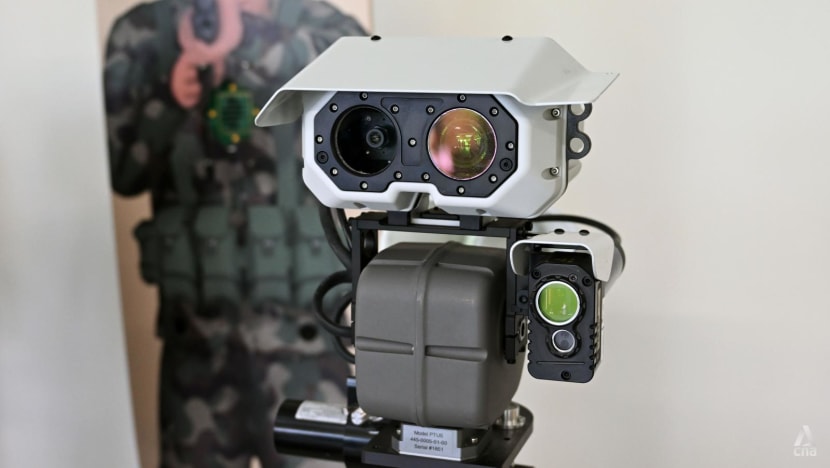Targets that 'shoot back', realistic battle effects part of SAF's new urban training
SAFTI City and three battle circuits with enhanced technology will open in 2024 as MINDEF moves to enhance training realism.

The static 2D human target at the Murai Urban Battle Circuit can quickly flip up or turn around to simulate a more realistic engagement for the soldiers. (Photo: CNA/Marcus Mark Ramos)

This audio is generated by an AI tool.
SINGAPORE: You’re walking down a stony path when the sharp popping sound of gunfire suddenly assails you. A muzzle flashes, and you see a weapon firing at you from behind a tree.
Then a blast roars through the air. You not only hear it, but feel some of its shockwave. Smoke fills the path ahead of you, making it hard to see.
Ducking for cover, you see a human shape shoot at you. You take aim with your firearm and pull the trigger, but nothing happens. The weapon doesn’t work anymore because you are “dead”.
Realistic battlefield effects, targets that shoot back with laser technology, and an enhanced system to track training performance are among the features of the new Murai Urban Battle Circuit.
When this battle circuit opens from April, up to 22,000 soldiers are expected to pass through each year to complete small-unit drill-based training.
Located within the Murai Urban Training Facility, it is one of three battle circuits using enhanced technology set to open this year as the Singapore Armed Forces (SAF) seeks to train soldiers more effectively.
Defence Minister Ng Eng Hen provided updates on SAF’s training capabilities during the Ministry of Defence’s (MINDEF) committee of supply (COS) session in Parliament on Wednesday (Feb 28).

The battle circuit in Ama Keng will be used to train with vehicles and defence systems, while the one in Pasir Laba will be used for jungle warfare. Both are projected to open from mid-2024.
All will be located south-west of Lim Chu Kang, in the same neighbourhood where phase one of the Singapore Armed Forces Training Institute (SAFTI) City will also open later this year.
SAFTI City, touted as a next-generation smart training facility, will feature diverse urban structures like public transport nodes, interconnected high-rise buildings and other public amenities.
The sprawling facility is estimated to be more than 100,000 sq m in size, and can support brigade-level training.
MINDEF has made sizeable investments to enhance training realism and effectiveness for national servicemen (NSmen) and regulars, said Dr Ng.
At Murai Urban Battle Circuit, for example, a system developed by ST Engineering allows instructors to control the battlefield effects and targets remotely from a tablet.
The same system also captures training performance data at the individual and team levels, and even playback of troop movements. These can be reviewed after the exercise for evidence-based learning.



Laser-based engagement means that when a target makes a critical “shot” at a soldier, the soldier’s firearm will stop working and a red light on their vest will flash to indicate they are “dead”.
This marks a move away from traditional methods of training that rely on verbal cues, said Lieutenant Colonel Lim Zhifeng, Head Training Capability Development Branch, HQ Training and Doctrine Command.
With a more realistic combat scenario in training, soldiers can better hone their tactical responses, said LTC Lim.
“Besides allowing better training oversight, it also allows us to employ the use of data analytics, as well as user-centric debriefing tools, to provide timely and objective feedback for our soldiers,” he added.
What goes into a realistic combat training scenario
The new Murai Urban Battle Circuit aims to provide a more realistic, immersive battlefield environment and data-based feedback on soldiers’ performance.
This is some of the technology being used to make that possible:
- Targets that “shoot back”: The targets come in static 2D, static 3D and mobile 3D versions. When they interact with soldiers wearing a laser-based system, the targets can identify, shoot at, and be shot by troops during training. The targets can also simulate body heat, allowing soldiers to train with night fighting equipment.
- Virtual avatar system: Virtual characters and settings can be configured into complex and realistic training scenarios, such as a hostage situation. The scenarios can involve civilians and hostile actors, who can also “shoot back” with lasers.
- Battlefield effect simulators: The simulators mimic the effects of large blasts and small firearms – including sounds, shockwaves and muzzle flashes – without pyrotechnics. They help to condition soldiers and refine battlefield instincts, according to MINDEF.
- Exercise Control System (EXCON): The system that pulls it all together, EXCON controls the targets and battle effects, as well as captures training data. It records measures of team and individual performance, like the time taken to complete drills and shooting accuracy. Trainers can also playback troop movements for review. This enables more objective, evidence-based feedback, according to MINDEF.
Dr Ng also updated parliament on the expansion of Shoalwater Bay Training Area in Australia’s Queensland, which is on track for completion this year.
The expansion will allow SAF to increase the scale of Exercise Wallaby – already its largest unilateral overseas training exercise – by close to 50 per cent, and lengthen its duration from six weeks to nine weeks.
Together with the development of the adjacent Greenville Training Area, SAF will have a combined training area 10 times the size of Singapore, up from four times currently.
SAF will then be able to deploy up to 14,000 staff and 2,400 vehicles and equipment annually, said Dr Ng. This would be an increase from the 4,300 staff and 450 platforms deployed to Shoalwater Bay last year.
A new Central Manpower Base located opposite Cashew MRT station is also on track to open in phases from 2025 to serve pre-enlistees and NSmen, with more details to come.
















